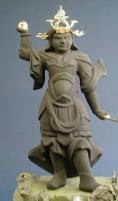:::::::::::::::::::::::::::::::::::::::::::::::::::::::::::::::::::::::::::::::::::::::::::::::::::::
Fudo Myo-O Gallery
:::::::::::::::::::::::::::::::::::::::::::::::::::::::::::::::::::::::::::::::::::::::::::::::::::::
Twelve Heavenly Generals 十二神将
juuni shinshoo
The 12 Heavenly Generals protect and serve the Yakushi Nyorai (the Medicine Buddha). They are also known as the Juuni Yakusha Taishou 十二薬叉大将, or Juuni Shinnou 十二神王. The 12 are Hindu Yasha 夜叉 who were later incorporated into Buddhism as protective warriors. In Japanese sculpture and art, they are almost always grouped in a protective circle around the Yakushi Nyorai -- they are rarely shown independently.
Many say they represent the twelve vows of Yakushi; others say the 12 were present when the historical Buddha introduced the "Healing Sutra;" yet others that they offer protection during the 12 daylight hours, or that they represent the 12 months and 12 cosmic directions, or the 12 animals of the 12-year Chinese zodiac. The Juni Shinsho are also members of the Tenbu (Sanskrit: Deva), a larger grouping of deities protecting the Buddhist realm.
Read more details HERE
Twelve Heavenly Generals
Mark Schumacher
Yakushi Nyorai, the Buddha of Medicine 薬師如来
Daruma Museum

Yakushi Nyorai and the 12 Warrior Generals
© www.buddha-art.com
:::::::::::::::::::::::::::::::::::::::::::::::::::::::::::::::::::::::::::::::::::::::::::::::::::::
Each of them represents one heavenly direction and one of the twelve hours of the day and twelve months of a year.
Time and space are one in their presence.

:::::::::::::::::::::::::::::::::::::::::::::::::::::::::::::::::::::::::::::::::::::::::::::::::::::
. . . . . H A I K U
隙間風十二神将みな怒る
sukima kaze juuni shinshoo mina okoru
wind through the cracks -
the twelve heavenly generals
look so angry
Awano Seiho 阿波野 青畝
1899年(明治32年)2月10日 - 1992年(平成4年)12月22日)
:::::::::::::::::::::::::::::::::::::::::::::::::::::::::::::::::::::::::::::::::::::::::::::::::::::
武器を持つ十二神将冴返る
buki o motsu juuni shinshoo saekaeru
the twelve heavenly generals
holding weapons -
cold is returning
© Tsuji Fumiharu 辻文治
:::::::::::::::::::::::::::::::::::::::::::::::::::::::::::::::::::::::::::::::::::::::::::::::::::::
しやくなげ太芽十二神将躍るかな
shakunage futoga juuni shinshoo odoru kana
rhododendron with big buds -
the twelve heavenly generals
are dancing
© Matsuta Hiromu 松田ひろむ
:::::::::::::::::::::::::::::::::::::::::::::::::::::::::::::::::::::::::::::::::::::::::::::::::::::
At the temple Shin Yakushi-Ji in Nara

紅葉照り伐折羅大将生きてをる
momiji teri Basara taishoo ikite oru
shining red leaves -
General Basara
is really alive
© Kenichi けんいち さん
. basara ばさら / 婆娑羅 flamboyant elegance .
::::::::::::::::::::::::::::::::::::::::::::::::::::::::::::::::::::::::::::::::::::::::::::::::::::::::::::::::::::::::::::::::::::::::::::::::::::::::::::::::::::::::::::::::::::::::::::::::::::::::::
Japanese LINK with illustrations
12 Himmlische Generale (Juuni Shinshoo)
Auch "12 Dämonen-Generale" (Juuni Yasha Taishoo) genannt.
Inkarnationen der 12 großen Gelübde des Yakushi Nyorai.
Sie gebieten jeder über 7000 Gefolgsleute, zusammen also 84 Tausend, um die 84 Tausend Leiden der Menschen durch Erleuchtung zu wandeln. Umgeben immer eine Statue des Yakushi Nyorai.
Man ordnet ihnen auch die 12 Tierzeichen, die 12 Doppelstunden eines Tages und die 12 Himmelsrichtungen zu. Ihre Namen enthalten die 12 Tierzeichen.
Jedem General entspricht auch ein Bosatsu und ein Nyorai.
Ikonografie:
Mit flammendend abstehendem Haar, in dem das entsprechende Tierzeichen dargestellt ist.
Furchterregender Gesichtsausdruck und dynamische Gebärden.
Rüstung oder Waffen im chinesischen Stil, mit Schwert, Hellebarde u.a.
Besonders bekannt sind die Lehm-Statuen im Tempel Shin Yakushiji, Nara.
Die ersten Namen stammen aus dem Yakushi-Sutra, die letzten Namen aus dem Daraniju-Sutra und die Namen in Klammern entsprechen der indischen Bezeichnung. Es folgt das Tierzeichen (zwei verschiedene Versionen) und der Gegenstand in der Hand, zitiert nach Tanaka:
Anteira, Antera, Andara (Anchira)
Affe. (Hase.) Wunscherfüllendes Juwel.
Basara, Baira, Nyokira, (Vajra)
Hund. (Rind.) Schwert.
Bikara, Bikatsura, Bikyara (Vikaalo)
Wildschwein. Dreizackiger Donnerkeil.
Gakunira, Manira, Anira (Anila)
Schaf. (Drachen.) Pfeil.
Haira, Hayara (Paayilo)
Drachen. (Schaf.) Pfeil und Bogen.
Indara, Indara (Indaalo)
Schlange. (Pferd.) Dreizack.

Kubira 倶毘羅, Konbira (Kumbhira)
Wildschwein. (Katze.) Großes Schwert.
In einem früheren Leben war er ein menschenfressendes Krokodil im Indus; wurde später bekehrt und zu einer schützenden Meeresgottheit. In Japan besonders im Kotohira-Schrein in der Konpira-Halle in Shikoku verehrt. Siehe auch Bishamonten.
Makora, Rakyuura (Mahaalo; Mahaaraaga)
Hase. (Affe.) Axt in der linken Hand.
Mekira, Mikyora (Mekhilo; Mihira)
Vogel. (Tiger.) Einzackiger Donnerkeil. Oder Axt in der rechten Hand.
Santeira, Santera, Sooranra
..... Pferd. (Schlange.) Schneckentrompete.
Shindara, Shindara (Cindaalo)
Tiger. (Vogel.) Kein Gegenstand.
Shatora, Shootora (Caundhulo)
Rind. (Hund.) Großes Schwert.
(c) Gabi Greve
Buddhastatuen (Buddha statues) Who is Who
Ein Wegweiser zur Ikonografie von japanischen Buddhastatuen
:::::::::::::::::::::::::::::::::::::::::::::::::::::::::::::::::::::::::::::::::::::::::::::::::::::
O-Fudo Sama Gallery
:::::::::::::::::::::::::::::::::::::::::::::::::::::::::::::::::::::::::::::::::::::::::::::::::::::
we have so much to learn...(and it`s a pleasure to learn via the informations on your blog!)
ReplyDeletethank you, dear Gabi!
best wishes,
Angelika
"Four Standing Junishinsho (Twelve Heavenly Generals): Chushin (Ox General), Inshin (Tiger General), Boshin (Rabbit General) and Yushin (Rooster General)" - from Honzan Jionji (Yamagata), dated 13th c. (Kamakura Period),
ReplyDelete- Classified as Important Cultural Property of Japan.
[Part of the current exhibit at the Tokyo National Museum, Masterpieces of Buddhist Sculpture from Northern Japan]
- The Twelve Heavenly Generals are the protective deities (Yaksha - in Sanscrit) of "Bhaisajyaguru" (in Sanscrit) the Buddha of Medecine in the Mahayana tradition of Buddhism. Each general represents one of the twelve vows of the Medecine Buddha:
(1) To illuminate countless realms with his radiance, enabling anyone to become a Buddha just like him.
(2) To awaken the minds of sentient beings through his light of lapis lazuli.
(3) To provide the sentient beings with whatever material needs they require.
(4) To correct heretical views and inspire beings toward the path of the Bodhisattva.
(5) To help beings follow the Moral Precepts, even if they failed before.
(6) To heal beings born with deformities, illness or other physical sufferings.
(7) To help relieve the destitute and the sick.
(8) To help women who wish to be reborn as men achieve their desired rebirth.
(9) To help heal mental afflictions and delusions.
(10) To help the oppressed be free from suffering.
(11) To relieve those who suffer from terrible hunger and thirst.
(12) To help clothe those who are destitute and suffering from cold and mosquitoes.
.
facebook
https://www.facebook.com/UkiyoESumiE/photos/a.555876614534135.1073741859.207467629375037/660357597419369/?type=3&theater
.
Yama no Kami 山の神 God of the Mountain
ReplyDeleteand juunisama, jūni sama 十二様 Juni Sama "Honorable 12",
another name for this male / female deity
.
https://japanshrinestemples.blogspot.jp/2017/10/yamanokami-juunisama.html
.
十二神将怒り秋日を強めたり
ReplyDeletejuuni shinsho okori shuujitsu o tsuyometari
twelve heavenly generals looking angry
the autumn days become stronger
.
Hosomi Ayako 細見綾子(1907~1997)
.
Twelve Heavenly Generals 十二神将
juuni shinshoo
https://darumamuseumgallery.blogspot.jp/2008/01/twelve-heavenly-generals.html
夜叉 yasha
ReplyDelete24 legends to explore
.
yasha oni 夜叉鬼
https://kappapedia.blogspot.jp/2018/03/oni-yama-mountains.html
.